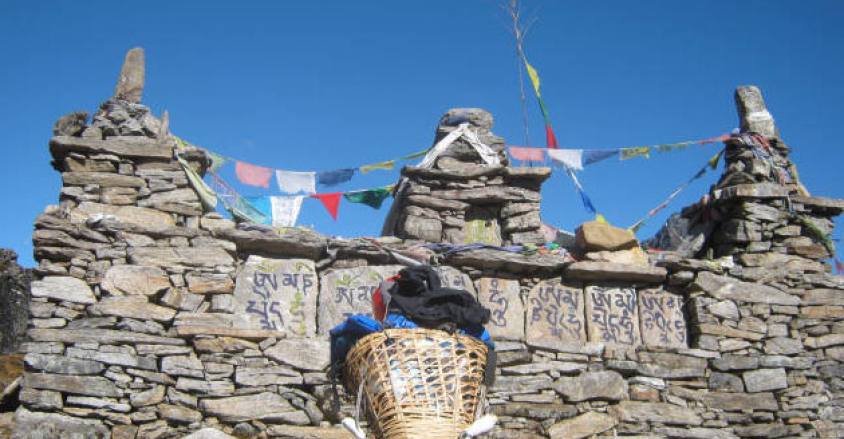
Makalu Base Camp Trek 20 Days
Tour Gallery
Overview
Discovering Makalu Region
Nestled in eastern Nepal, the Makalu Base Camp Trek is a hidden gem that beckons adventurers seeking an off-the-beaten-path experience. The Makalu region, home to the fifth-highest peak in the world, Mount Makalu (8,485 meters), offers a pristine wilderness that remains relatively untouched by mass tourism. This section introduces readers to the allure of the Makalu region and the unique appeal that sets it apart from more frequented trekking destinations.
The Route Unveiled
Embarking on the Makalu Base Camp Trek takes trekkers through a kaleidoscope of landscapes. From lush, subtropical forests teeming with biodiversity to high-altitude alpine meadows and glacial moraines. Every step on this journey reveals a new facet of nature’s beauty. The trek’s itinerary is laid out, detailing the day-to-day trail and offering insights into the challenges and rewards awaiting trekkers.
Makalu Barun National Park
The Makalu Base Camp Trekking is not just a walk. It’s an immersion into the natural wonders of the Makalu Barun National Park. This segment explores the region’s incredible biodiversity, from elusive wildlife such as red pandas and snow leopards to a myriad of bird species. The park’s conservation efforts contribute to preserving this unique ecosystem, making it a haven for nature enthusiasts.
Makalu Base Camp
Reaching the Makalu Base Camp is the culmination of the trek, and this section paints a vivid picture of the awe-inspiring scenery that unfolds at the base of Mount Makalu. Surrounded by towering peaks like Chamlang and Baruntse, trekkers are treated to panoramic views that showcase the grandeur of the Himalayas. The article highlights the sense of accomplishment and reverence that comes with standing at the foot of these majestic giants.
Cultural Encounters
Beyond the natural wonders, the Makalu Base Camp Trek provides an opportunity for cultural immersion. Trekking through remote villages inhabited by diverse ethnic communities, including the Sherpas, Rai, and Limbus, offers a glimpse into the traditional way of life in the Himalayas. Trekkers can engage with locals, witness age-old customs, and partake in the warmth of mountain hospitality.
Challenges and Rewards
Traversing the Makalu region’s rugged terrain comes with its challenges. This part of the guide discusses the physical and mental aspects of trekking at high altitudes, acclimatization strategies. And the importance of being prepared for the ever-changing mountain weather. The challenges, whether crossing high passes or navigating steep ascents, outweigh the rewards of breathtaking views and a sense of accomplishment.
Tea Houses and Accommodations
The Makalu Base Camp Trekking isn’t just about roughing it out in the wild. Trekkers can enjoy the comfort of tea houses along the trail, providing a cosy retreat amidst the rugged landscapes. This section details the accommodations available, the hospitality of the teahouse owners, and the communal atmosphere that adds to the charm of the trekking experience.
The Best Time to Trek
Timing is crucial when it comes to trekking in the Himalayas. This segment provides insights into the best seasons for the Makalu Base Camp Trek, considering factors like weather, trail conditions, and the blooming of rhododendrons. Whether it’s the vibrant spring or the crisp autumn, understanding the seasonal variations enhances the trekking experience.
Conclusion
In conclusion, the Makalu Base Camp Trek is more than a journey; it’s a symphony of nature and adventure that resonates with every step. From the hidden valleys to the towering peaks, the trek encapsulates the essence of the Himalayas in its purest form. For those seeking an authentic and transformative trekking experience. The Makalu Base Camp Trek stands as an unrivalled choice, promising memories etched in the heart forever.
Trip Highlights
- ☞Mount Makalu is named after the Hindu God “Maha Kala,” otherwise known as Lord Shiva.
- ☞Mount Makalu is one of the most challenging mountains to climb.
- ☞Kangchungtse and Chomo Lonzo are subsidiary peaks of Mt. Makalu.
- ☞Lionel Terray and Jean Couzy first climbed Mt. Makalu in May 1955.
What's Included
Included Services
- ✓Airport pick up and drop off, upon arrival and departure in Kathmandu (International and domestic both)
- ✓Makalu Base camp all required permit fee and Makalu Barun National Park entrance fee
- ✓Flight ticket to Tumlingtar both ways
- ✓Food and accommodation during the trek and climb (full board with breakfast, lunch and dinner with tea/coffee and seasonal fresh fruits)
- ✓One licensed English or Chinese or Korean or Hindi along with Nepali speaking trekking guide
- ✓Transportation, food, accommodation and insurance of Guide during the trip
- ✓Down jacket, all-season sleeping bag, duffel bag and trekking map(in case if you don't have your own. Down jacket, sleeping bag and duffel bag must be returned after completion of the trip)
- ✓First Aid Medical Kit(Carried by the guide)
- ✓Porter
- ✓Hotel in Kathmandu
Optional Addons
Excluded Services
- ✗International Airfare
- ✗Visa Charges
- ✗Your travel and medical insurance
- ✗Personal Expenses such as shopping, bar bills, hot shower, telephone, laundry, titbits etc
- ✗Services not mentioned or not promised by the Agent / Agency
- ✗Emergency expenses such as expenses on charted Flights / Helicopter
Detailed Itinerary
More Information
Permit & Cost for Makalu Base Camp Trekking and Itinerary
The trek to Makalu Base Camp consists of multiple permits and documents. These permits are the record that helps manage tourism in Nepal Including some basic things such as tax.
You will be requiring the Makalu Barun National Park Permit. For this, you must consult with the Nepal Tourism Board and you will get the permit without any problem. This may sometimes take days. Thus, proper management of time is necessary both when solo trekking or trekking with an agency.
Another important must-have document is the Trekkers’ Information Management Systems (TIMS) Card. For this, you will have to go to Pokhara or Kathmandu. Usually, most of the trekking agencies include this card on their package, so it will not give you a headache when trekking with an agency. In case of solo trekking, you must run to various places mentioned above to get permits and passes.
Also for your extra knowledge, Makalau Base Camp trek being slight remote than any other trek has been reported of bandits. Thus, solo trek is not encouraged and you must consult an expert before trekking
Can you see Everest from Makalu?
For many getting a glimpse of Mt. Everest is a big deal. Even for someone experienced, the view of Everest is unlike that they ever saw. Everest is something that stays on your mind even when you trek another region. The significance that this peak holds is simply incomparable. Even while trekking Makalu Base Camp the question for many is will I be able to see Everest from the base camp? The answer to this is Yes! You can. You get a wholesome view of the great Everest standing proud at a distance through a viewpoint located in Makalau Base Camp.
Lying at an altitude of about 5100m, this Makalu Base Camp viewpoint gives you a panoramic view of multiple great peaks. And Everest tends to be one of them. Makalu Base Camp is a trek that is not limited to its region, you get to experience stunning views of peaks like Everest(8849m), Baruntse(7200m), and Lhotse(8516m)
How difficult is Makalu Base Camp Trek considered?
When comparing the Makalu Base Camp trek to well-known treks such as Everest Base Camp Trek and Annapurna Circuit, Makalu tends to be more difficult and draining for an individual. Everest and Annapurna region gaining a lot of popularity has become a role model trek for others to compare their trek with. More experienced ones often perform Makalu Base Camp Trek as they know the pros and cons. What makes this trek more difficult you may ask?
Factors such as Remoteness, rugged natural trails, and the great incline make it more difficult than treks such as Everest and Annapurna. This Trek being underrated defines why remoteness exists in the such trek. With no facilities and paths like the world-renowned treks. Makalu Base Camp Trek may be draining and challenging for a beginner. A wise decision would be start with an easier grade trek such as Everest and later come up with more experience to conquer this piece of Nature. But it is totally upto you. With great assistance and enough knowledge, everything is possible.
Where is Makalu base camp?
Makalu Base Camp is located 10km South-East of Mt. Everest, being a part of the Mahalangur Himalayan range. This trek begins from Tumlingtar, which is an hour’s flight from Kathmandu. From Tumlingtar, a drive of about three hours takes you to Chichila which is the real starting point of the trek.
Many may not know the exact location of Makalu Base Camp as this slightly bends towards the underrated trek. By no means underrated means this trek is inferior to other treks. As what it means is Makalu Base Camp is a harder trek, usually, people tend to trek its alternative. But when it comes to the content and feature of this trek. It doesn’t lack behind.
Makalu Base Camp is located 10km South-East of Mt. Everest, being a part of the Mahalangur Himalayan range. This trek begins from Tumlingtar, which is an hour’s flight from Kathmandu. From Tumlingtar, a drive of about three hours takes you to Chichila which is the real starting point of the trek.
Compared to other popular treks, this one is a bit extreme and remote. Thus, do not expect a social life while trekking Makalu Base Camp. As only if luck favours you may be able to charge your devices once in several days. Settling at an altitude of about 5100m, a great trek awaits you.
Kathmandu to Transportation for Makalu Trek
The real trek to Makalu Base Camp starts from the point called Tumlingtar. From there it is all just trek and slopes. But until Tumlingtar there are few means of transportation that you can take for your comfort.
Ultimately two means of transport are there to reach Tumlingtar, one is you can take a bus from Kathmandu or get your private vehicle and travel to Tumlingtar which is almost 500km far from the capital. Another alternative is that you can take a quick flight of about 45 mins to reach Tumlingtar to continue with the Trek. For most travel by air is the best bet for more comfort and a great way to save energy. Thus, it is the best bang for the buck
Food and accommodation during Makalu Base Camp Trek.
20 days of itinerary is a whole lot of time, such massive time you must need proper accommodation and meals to fuel your body to keep going on. Without proper accommodation and meals, trekking such a hard trek is really impossible.
The places where we spend our nights throughout the treks are called tea houses. Tea houses are small wooden houses built for trekkers and hikers in that region. With proper meal serving(mostly dhal bhat) you get to sleep at comfort in these tea houses. But going up to higher altitudes, the condition of these tea houses may slightly vary. You cannot expect modern systems and facilities at such tea houses as the trek is in quite a remote area. Consider yourself lucky if you find yourself hot water and electricity.



